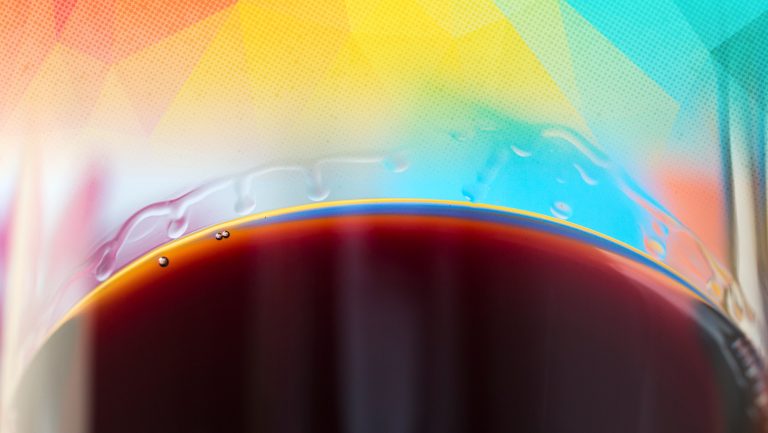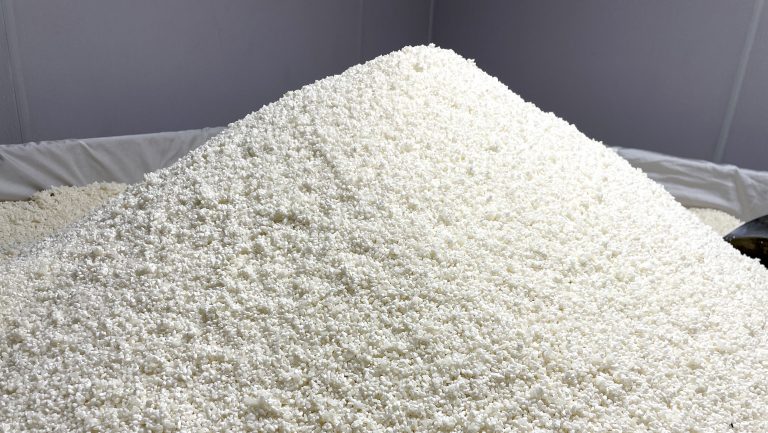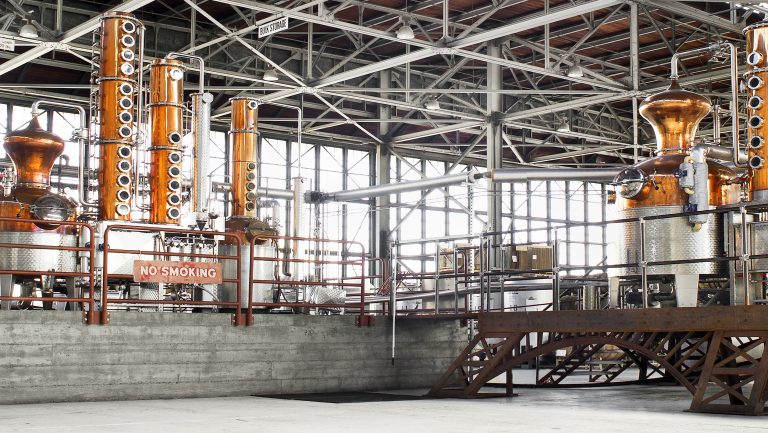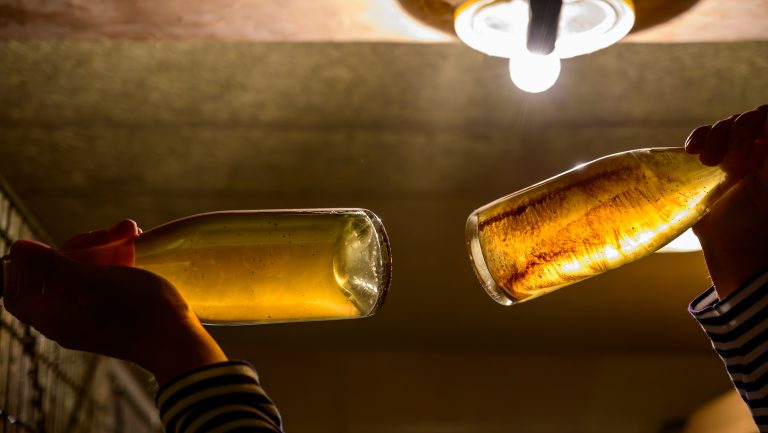Although color is obviously the first thing one sees when encountering a wine, this visual aspect is the least important thing to consider when enjoying a glass of wine. However, there is much more to wine color than meets the eye.
For the grapevine itself, berry color is largely responsible for grapevines’ ability to survive the throes of evolution. In red wine, color is a major factor in determining its mouthfeel and ageability. By considering how color functions in wine throughout the winemaking process, producers can make choices that determine its stability, mouthfeel, and longevity.
How Grapes Use Color to Survive and Thrive
Plants use color in a variety of ways. In some, tender, emerging leaves start off bright red to appear inedible to herbivores, or to act as a sun protectant, with leaves changing to green as they thicken and become less vulnerable.

Don’t miss the latest drinks industry news and insights. Sign up for our award-winning newsletters and get insider intel, resources, and trends delivered to your inbox every week.
In grape berries, color is used in the opposite fashion: to beckon animals to eat them. Grapes do not begin to turn red until the seeds are viable; color is used as a signal to attract fauna to eat the fruit and seeds, which are then digested. In this way, the seeds—and therefore the plant’s genes—are dispersed over a much larger territory than the vine itself would be capable.
White grapes rarely occur in nature, requiring two distinct mutations. Lacking color—and thus the ability to attract dispersers of their seeds—puts white grapes at a significant evolutionary disadvantage. They have humankind to thank for their current widespread existence; most researchers and wine historians believe that all cultivated white vinifera varieties can be traced back to a single ancestor vine that was lucky enough to be noticed by a human.
How Anthocyanins and Skin Thickness Affect Grape Color
Plants use a variety of pigments for coloration (for example, carotenoids, chlorophyll, and betalains), but in grapes, it is the versatile anthocyanin that dominates. Anthocyanins are phenolic compounds that are structurally similar to tannins, and as many as 20 types can be found among vinifera grapes. The pigment can express itself in a number of hues, depending on the specific type and the pH of the surrounding tissue. The lower the pH, the further the color shifts toward the red end of the visible light spectrum; the higher it is, the more the hue tends toward the blue end.
Anthocyanin concentration also affect mouthfeel and can actually mean longer life for a wine, giving it more time to slowly unfold and reveal its potential. Different grape varieties and clones have differing types of anthocyanins and skin thicknesses, which affect coloration. Skin thickness is also an important factor in determining tannin concentration in grapes.
Soil that’s particularly high in calcium—such as limestone—results in thicker skins, providing sturdier structure to the grape, but climate can affect grape color, too. “In hot climates or years, grapes develop too quickly, and skins are thinner,” says Robert Jordan, the owner of Grand Crew Vineyard Management in Napa, California. “When you have thin skins, you have less color.”
Like most aspects of winemaking, the work done in the vineyard is critical, and this includes protecting a grape’s color. “Color where grapes are sunburned is not extractable,” says Jordan. “When de-leafing, it’s important to do so early during grape development, which results in the grapes accumulating the necessary amount of phenolics for protection. Leafing later in the season, post-veraison, can result in sunburn, as the grapes have not built up their natural sunscreen.”

Color During Fermentation
During winemaking, color begins extracting immediately upon crushing—color is soluble in must at lower temperatures. Color extraction reaches its greatest concentration within five to eight days of maceration. There is always a slight decline in color concentration after this zenith. Whole-cluster fermentations lose even more color, as stems absorb a significant amount of color molecules—wines that see stem inclusion often have a lower color density. Lees, too, absorb and break down color.
Color concentration reaches its maximum during fermentation regardless of punchdown frequency, fermentation temperature, and enzyme use. Because color extraction reaches a ceiling—regardless of standard winemaking practices—it can only be improved with techniques that increase copigmentation cofactors. Also simply called “cofactors,” these are monomeric phenolic compounds (such as quercetin and gallic acid) that temporarily bond with anthocyanins during extraction, making them available for later polymerization.
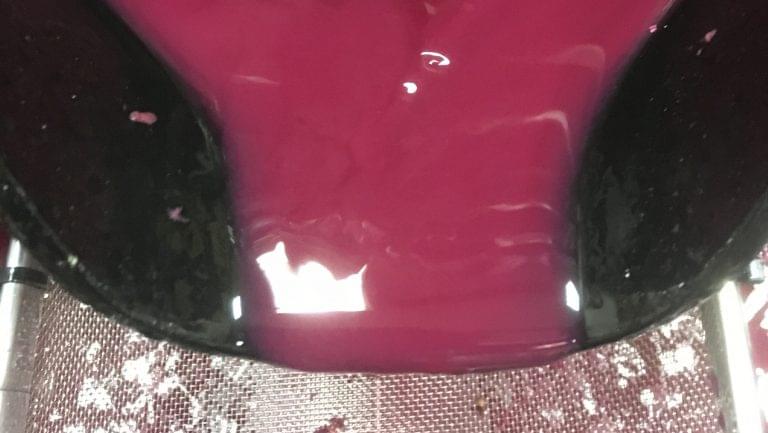
How Anthocyanins Can Affect a Wine’s Flavor and Texture
Shorter and more abundant tannin and color polymers may lead to greater reductive strength. Although it’s a relatively new area of interest for winemakers, a wine’s reductive strength—its antioxidant capacity, or ability to absorb oxygen without oxidizing—is proving to be critical in determining its longevity.
“Tannins polymerize and grow larger until they are capped on both ends by a color molecule, which stops growth,” says Bruce Zoecklein, PhD, a professor of enology at the College of Agriculture and Life Sciences at Virginia Tech in Blacksburg who studies this phenomenon. “A higher ratio of color to tannin means shorter polymers and may lead to greater reductive strength [and thus the ability to absorb oxygen over time without oxidizing]. Tannin-anthocyanin polymerization in wine is facilitated by oxygen during the early life of a wine.”
To put it simply, color is preserved and retained in wine by bonding with tannins, and vice versa. Shorter anthocyanin-tannin polymers also result in a softer mouthfeel. Long tannin chains, which can result from a low ratio of anthocyanins to tannins or when polymerization occurs in the absence of oxygen, typically result in a higher degree of astringency.
As understanding of the importance of anthocyanins increases, there is renewed interest in anthocyanin concentration as a factor in determining pick time. Anthocyanin accumulation plateaus at a certain point during ripening. Traditionally, concentrations of anthocyanins could not be easily measured by winemakers, but new technologies are changing that. Zoecklein believes that in the future, “harvest decisions may be made based on monitoring vine hormone concentrations or balances, such as that of abscisic acid, by which it may be possible to determine peak concentration of selective grape components, such as anthocyanin concentration, as well as extractability.”
Increased Reductive Strength Can Lead to Longer-lived Wines
Zoecklein notes that winemakers are in the early stages of understanding these phenomena. Although he believes the future of efforts to maximize reductive strength in wines may be in the vineyard rather than the winery, there are two technologies that winemakers can use to help ensure early polymerization to maximize reductive strength: microoxygenation during and/or immediately following alcoholic fermentation (known as phase one microoxygenation), and exposing wines to increased temperatures post-fermentation. With the focus these days on low intervention and “natural” winemaking, wine technologies are often considered taboo, but practices such as these are simply ways to give a wine a bit more oxygen than a barrel happens to provide—not heavy-handed manipulation.
“How can I ensure with each vintage that I am crafting wines with long life spans and the ability to age and evolve?” says Massimo DeVellis, a winemaker based on Long Island, New York, and the founder of soon-to-launch Vinicola Insieme. DeVellis not only makes use of microoxygenation for certain wines, he also occasionally coferments or uses oak adjuncts to increase the available anthocyanin-to-tannin ratio, as “you can’t stabilize what you don’t have.”
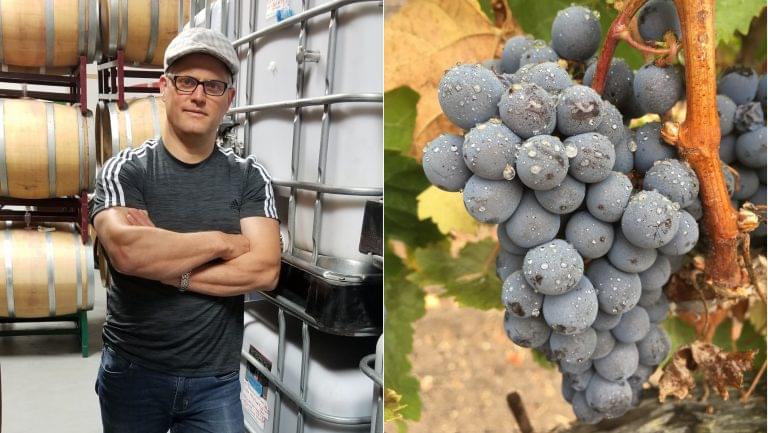
Left: Winemaker Massimo DeVellis Photo courtesy of Vinicola Insieme. Right: Cabernet Franc grapes on the vine. Photo by Alex Russan.
DeVellis’s interest in these techniques stemmed from his noticing that the wines he’d made that lived the longest—as well as older Bordeaux he tasted that aged especially well—precipitated the least color in bottle. “Color stabilization became one of the most important aspects to me during fermentation and cellaring,” he says. “When color precipitates, a wine’s life can be cut short, and you don’t actually get to see everything it’s capable of long term.”
None of this is to say that wines that have lower concentrations of color cannot age well—many of the longest-lived Pinot Noirs are light in color. Of course, there are other factors that lead to wine’s resistance to aging: acidity levels, alcohol and sugar concentration, perhaps even lees aging and minerality. However, a red wine’s reductive strength, of which color is a huge part, is an extremely important overall factor.
At the most basic level, without their red color, grapevines—and wine—may not have captured the attention of the many generations of seed dispersers that helped them survive over time. Likewise, an old, well-developed red wine may not have reached such a ripe old age with less color. By taking color into account, in both the vineyard and winery, winemakers can fine-tune their wine according to their stylistic goals, softening mouthfeel, or aiming to extend a wines life.

Dispatch
Sign up for our award-winning newsletter
Don’t miss the latest drinks industry news and insights—delivered to your inbox every week.
Alex Russan, based in Los Angeles, is a former winemaker, importer, and sherry bottler. He writes about viticulture, enology, tasting and the nature of wine

